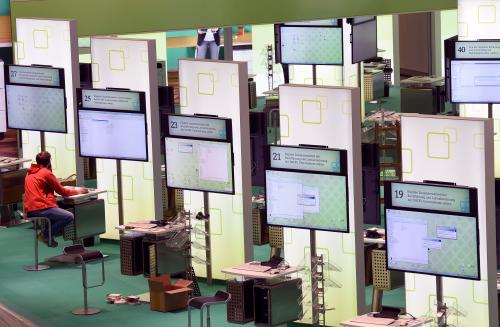A month ago, Brookings Metro published a report warning that just as the gains from economic growth were distributed unevenly over the last few decades, the losses from automation will also hurt some groups and places more than others. In the U.S., robots will take jobs from men, the young, and minorities. The losses will not be shared evenly across places either. Jobs in the northeastern corridor are much less vulnerable than those in the Midwest and Texas, for example.
In a recently published working paper, we ask a related question: Do robots in the United States destroy jobs in Mexico? According to our findings, the answer is a qualified “yes.” Automation may hurt not only American workers, but also those in countries with strong trade links to the U.S.
The Long Reach of Robots
Here is an example of how this process works. A car manufacturer in Detroit decides to upgrade its production process and invest in robots to automate the production of engines. This would replace several workers. But after decades of jobs being offshored to other countries, it is no longer obvious that all these workers live in Detroit. Many of them are likely to live in foreign cities such as Chihuahua, where hundreds of Mexican workers assemble car parts for American companies. In other words, automation in the U.S. may cause unemployment in Mexico by bringing back jobs… to American robots.
But the story is not quite so simple, nor always catastrophic. Robots also increase productivity in the U.S., which could lead to greater demand for intermediate and consumer products from Mexico, and so create more jobs for Mexicans (though not necessarily in Chihuahua). And some Mexican businesses may be able to cope with the shock by selling their products to other countries.
To explore the labor market effects of U.S. automation on Mexico through this trade channel, we conducted the following experiment. We ranked Mexican local labor markets according to their “exposure” to automation in the U.S. Intuitively, a city with exports to the U.S. heavily concentrated in sectors such as the automotive and plastics industries—that are automating rapidly in the U.S., but increasingly also elsewhere—is more likely to experience a decline in total exports than a city with exports concentrated in, say, furniture, where automation is still less common.
We estimate that automation in the U.S. accounted for a 3.35 percent decline in exports from Mexico to the U.S. During the period we study (2004-2014), Mexican exports to the U.S. actually increased from $155 billion to $295 billion. Without automation, this number would have been approximately $5 billion higher. The numbers seem small when you consider the aggregates, but they are not negligible either. More worrying is the suspicion that they might be the trickle that turns into a flood.
End of the maquiladora?
But what are the consequences for Mexican workers? The affected firms may have had to lay off employees to cope with the lower demand for their products from the U.S. Not surprisingly, we don’t find a negative effect from U.S. automation on overall employment in Mexico. The decline in trade and the share of employment in the tradable sectors are likely too small to observe such an effect in the data. Yet, we also find no effect when zooming in on wage or formal jobs in the tradable sectors (as opposed to overall employment), or even on wage employment just in manufacturing. Even in Mexican districts where manufacturing jobs were initially more prone to be automated—because they required tasks more easily executed by robots—the decline in manufacturing wage jobs was negligible.
Overall employment in Mexico was also not affected by automation within Mexico. Yet, it did induce a shift from wage to informal employment. Most surprisingly, however, these shifts were much smaller in districts dominated by the automobile industry. This is where automation in the U.S. is larger, but also already present in Mexico. The automobile industry has been one of the first movers in automation, and automation will also expand to developing countries as experience with automation increases and the price of robots drops. This will enable developing countries to win back business and jobs that may have been lost in the early phases of the automation.
Worry about human capacities, not an invasion of the machines
These findings should help allay the Armageddon-type views about the impacts of automation. To be sure, there is growing evidence that robots destroy jobs, especially those staffed by unskilled and semi-skilled workers. But that may not be the main problem. In many developing countries, the lack of capacity to adopt new technologies—not an impending invasion by robots— is arguably the more important challenge. Digital development is, and should be, a key policy in the race to create full and productive employment and decent work for all (Sustainable Development Goal 8). Mexico may end up being hurt more by its inability to absorb new technologies from abroad than by American (or Mexican) robots.
Instead of spending time trying to predict how many jobs are going to be destroyed by robots, our energies might be better spent on assisting countries like Mexico to employ innovative technologies. It will not be easy, but it may be a more profitable enterprise. Albus Dumbledore couldn’t have said it better:
The consequences of our actions are so complicated, so diverse, that predicting the future is a very difficult business indeed.








Commentary
Are robots in Michigan destroying jobs in Chihuahua?
February 25, 2019